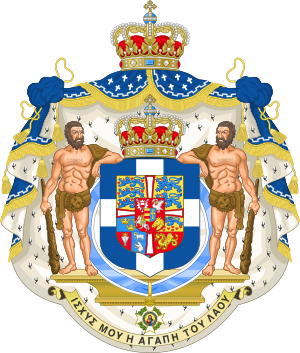Line of succession to the former Greek throne
The Greek monarchy was abolished by the then-ruling military regime on 1 June 1973, an act that was repeated by plebiscite on 8 December 1974 after the regime's fall. The title of king is used by the last reigning monarch, Constantine II (r. 1964–1973). His son, the Crown Prince Pavlos, who was born in 1967, is the heir apparent to the title.
Law of succession[edit]
According to Article 45 of the Greek Constitution of 1864 [1] and the Greek Constitution of 1911,[2] the crown descended according to primogeniture among the descendants of George I, males before females. In 1952, the succession clause was clarified to stipulate that the crown is inherited with preference to the descendants of the current king in order of primogeniture, the males taking preference,[3] i.e., the sovereign's sons (and their descendants, in respective order) inherit according to seniority of age among siblings with males before females, followed by the sovereign's daughters (and their descendants, in respective order) in like manner.
Current situation[edit]
 King Paul (1901–1964)
King Paul (1901–1964) King Constantine II (born 1940)
King Constantine II (born 1940)- (1) Crown Prince Pavlos (b. 1967)
- (2) Prince Constantine-Alexios (b. 1998)
- (3) Prince Achileas-Andreas (b. 2000)
- (4) Prince Odysseus-Kimon (b. 2004)
- (5) Prince Aristidis-Stavros (b. 2008)
- (6) Princess Maria-Olympia (b. 1996)
- (7) Prince Nikolaos (b. 1969)
- (8) Prince Philippos (b. 1986)
- (9) Princess Theodora (b. 1983)
- (1) Crown Prince Pavlos (b. 1967)
- (10) Princess Irene (b. 1942)
Line of Succession in June 1973[edit]
Notes[edit]
According to the 1864 and 1911 Greek Constitutions[edit]
- Prince Philip renounced his rights to the Greek and Danish thrones, as well as his Greek titles on 28 February 1947 before his marriage to Princess Elizabeth (later Queen Elizabeth II). He was awarded the title the Duke of Edinburgh on his wedding day by George VI and after being granted the title of Prince by his wife in 1957 was styled Prince Philip, Duke of Edinburgh.
- Prince Peter was deemed to have forfeited his succession rights by marrying a twice-divorced Russian commoner Irina Aleksandrovna Ovtchinnikova in 1939.
According to the 1952 Greek Constitution[edit]
- Princess Sophia, elder sister of Constantine II, relinquished her rights to the throne of Greece in 1962 when she married the then Juan Carlos, Prince of Asturias,[6] so neither she nor her descendants appear in the line of succession.
- Prince Michael renounced his rights to the throne upon his morganatic marriage to Marina Karella.[7][8]
- Princess Alexia converted from Greek Orthodoxy to Roman Catholicism after marrying Carlos Morales Quintana, therefore giving up her and her children's succession rights.
References[edit]
- ↑ British and Foreign State Papers. Volume 56. British Foreign Office. 1870. p.577. (In French)
- ↑ 1911 Constitution
- ↑ Norfid
- ↑ Kongelig dansk hof- og statskalender 2013. Statshåndbog for kongeriget Danmark - udgivet ved foranstaltning af Hendes Majestæt Dronningens Kabinetssekretariat og Statsministeriet i forening, Digitaliseringsstyrelsen, 2013 ISBN 978-87-995647-7-4 Search this book on
 .
. - ↑ The Greek Royal Family: The Royal Family
- ↑ Kerr, Stephen. The Juridical Analysis of the Succession to the Headship of the Royal House of Bourbon Two Sicilies. 1973. International Academy for the Promotion of Historical Studies. 2005, retrieved 15/06/2010.
- ↑ "Prince Michael Weds Commoner", The New York Times, 8 February 1965, page 3.
- ↑ Willis, Daniel (1999). The Descendants of Louis XIII. Baltimore, MD: Clearfield Co. pp. 94, 762. ISBN 0-8063-4942-5. Search this book on


Nenhum comentário:
Postar um comentário